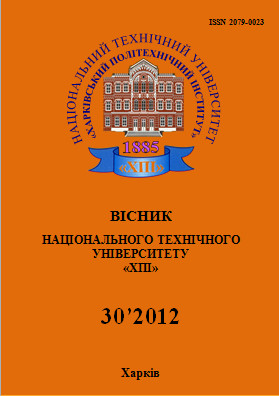Разработка математической модели каскада гидроэлектростанций
DOI:
https://doi.org/10.20998/%25xAbstract
В статье рассматривается задача математического моделирования гидроэнергетической системы в условиях нестационарного речного стока. Получена математическая модель каскада гидроэлектростанций для анализа динамических процессов основных водноэнергетических показателей ГЭС. Проведено имитационное моделирование на примере каскада двух ГЭС.References
Гидроэнергетика / А. Ю. Александровский, М. И. Кнеллер, Д. Н. Коробова и др.; под ред. В. И. Обрезкова. – М. : Энергоатомиздат, 1988. – 608 с.
Litrico X. Robust continuous-time and discrete-time flow control of a dam-river system / X. Litrico, D. Georges // Applied Mathematical Modelling – 1999. – N 23. – P. 809–827.
Tuszynski K. Hydro Plant – a Modelica Library for Dynamic Simulation of Hydro Power Plants / K. Tuszynski, J. Tuszyński, K. Slättorp // The Modelica Association – Modelica 2006, September 4th – 5th. – P. 251 – 257.
Naresh R. Two-phase neural network based solution technique for short term hydrothermal scheduling / R. Naresh and J. Sharma // IEE Proc.–Gener. Transm. Distrib., Vol. 146. – No. 6, November. – 1999. – P. 657–663.
Glattfelder A. Hydropower reservoir level control: a case study / A. Glattfelder, L. Huser // Automatica – 1993. – Vol. 29. – P. 1203–1214.
Любчик Л. М. Разработка математической модели управляемого каскада водохранилищ / Л. М. Любчик, О. В. Костюк, Д. Н. Нурмахматов // Вісник НТУ "ХПІ". – 2007. – № 39. – С. 97–100.
Downloads
Published
How to Cite
Issue
Section
License
Copyright (c) 2016 Вісник Національного технічного університету «ХПІ». Серія: Системний аналiз, управління та iнформацiйнi технологiїAuthors who publish with this journal agree to the following terms:
- Authors retain copyright and grant the journal right of first publication with the work simultaneously licensed under a Creative Commons Attribution License that allows others to share the work with an acknowledgement of the work's authorship and initial publication in this journal.
- Authors are able to enter into separate, additional contractual arrangements for the non-exclusive distribution of the journal's published version of the work (e.g., post it to an institutional repository or publish it in a book), with an acknowledgement of its initial publication in this journal.
- Authors are permitted and encouraged to post their work online (e.g., in institutional repositories or on their website) prior to and during the submission process, as it can lead to productive exchanges, as well as earlier and greater citation of published work (See The Effect of Open Access).


